Bengali cuisine
Bengali cuisine (Bengali: বাঙালি খাবার) is a culinary style originating in Bengal region in the eastern part of the Indian subcontinent, which is divided between Bangladesh and the Indian states of West Bengal, Tripura and Assam's Barak Valley. There is an emphasis on fish, vegetables, and lentils served with the staple rice.
| Part of a series on the |
| Culture of Bengal |
|---|
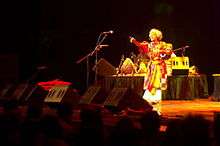 |
| History |
|
|
Mythology and folklore |
| Cuisine |
|
Festivals
|
|
Genres
Institutions
Awards
|
|
Music and performing arts Folk genres Devotional Classical genres
Modern genres
People Instruments Dance Theater
Organizations People |
|
Sport
|
|
|
| Part of a series on |
| Bengalis |
|---|
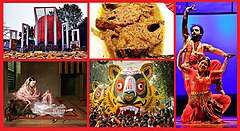 |
|
Bengali homeland |
|
Bengali culture
|
|
Bengali symbols |
Many Bengali food traditions draw from social activities, such as adda, or the Mezban.
Bengali cuisine is known for its varied use of flavours, as well as the spread of its confectioneries and desserts. It has the only traditionally developed multi-course tradition from the cuisine of the Indian subcontinent that is analogous in structure to the modern service à la russe style of French cuisine, with food served in courses rather than all at once.
History
Influence of widows
In Hindu patriarchal tradition, widows are not allowed to eat foods that would not be classified as "bitter", necessitating experiment and innovation.[1] While most Bengali castes ate meat and fish, this was barred for widows. Widows also could not use "heating" foods such as shallot and garlic, but ginger was allowed. This style found a core place in Bengali curries in general, both vegetarian and non-vegetarian. Expensive spices such as saffron, cinnamon or cloves were used very sparingly—if at all. Nuts, dry fruits, milk and milk products (such as cream, ghee or curd) were similarly scarce.[2] These economic and social restrictions influenced Bengali widows to create a brand new set of meals that utilized only vegetables and cheap spices.
Partition of Bengal and India
The large-scale displacement along religious lines as a result of the partition led to changes in meal-taking, as to adhere to religious restrictions. In Bangladesh, Mughlai food is common, and includes foods that are less popular in West Bengal, such as beef kebab. Additionally, more traditionally Islamic sweets such as zarda and firni-payesh are eaten. In rural Bangladesh, many people eat makna fried, popped, or raw.[3][4]
In West Bengal, the only restriction is beef, which applies only to Hindus.[5] During the colonial period, many Western food shops were established in Kolkata, making puff pastries, channa, chocolate, and chips especially popular. Dishes such as chop, gravy cutlet, sponge rasogolla, and ledikeni.[3] As a result of a multi-cultural community, Kolkata city's cuisine continuously changes, and takes heavy influence from Chinese and Marwari palates.[4][6]
Culture
Adda
Adda (Bengali: আড্ডা) is a traditional Bengali means of socialising over food during the work day. Food taken during adda consists usually of mishti or sweetmeats, tea, and coffee, although heartier meats such as fried fish may be brought out as well.
The adda first saw its rise during the colonial era, for guild members to meet and talk about a range of topics:[7]
"You could be discussing Charles and Camilla's marriage this moment, and the next moment you're swinging over to the latest cricket series between India and Pakistan, and then swing back to the recent controversy over Tagore."[8]
Being a hobby for artisans, women were largely secluded from adda, a sentiment that has begun to disappear with the democratization of adda and women occupying a larger space in social life. For this reason, adda was seen as a refuge "...from the home, a neutral rendezvous away from both the perceived drudgery of the workplace and domesticity".[7]
In the post-colonial era, the adda has been fading due to the more rigid structure of work and exploitative perceptions of unnecessary laziness. This has inspired a sizeable movement of Bengalis who believe it integral to the idea of lyadh, or doing nothing to relax and recharge.[7] However, adda does still exist, being attended during vacation time or after work at clubs or coffee shops. The tradition even has an equivalent to the Greek symposium, as students may meet for a study session over food or have a teacher teach in a more relaxed environment.[9]
Mezban
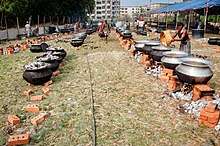
Mezban (locally known as Mejjan) is one of the popular social festivals of the Chittagong region in Bangladesh. The word "Mezban" in Persian means host and "Mezbani" means hosting or arranging a feast for the guests.[10] Historically Mezbani is a traditional regional feast where people are invited to enjoy a meal with white rice and beef, besides other dishes,[11] is held on the occasions such as death anniversary, birth anniversary, own successes, launching of a new business, entry into a new house, the birth of a sought after child in a family, marriage, aqiqah and circumcision, ear piercing of girls and naming of the newborn.[10][11] The invitation of the Mezban ceremony generally remains open for all and various people to different places and neighborhoods convey the invitation for the feast. The invitation cards are printed and distributed among the guests only in urban areas. Usually, the consumption of food at Mezbani takes place from morning to afternoon.[10]
Traditionally Mezban is a beef-dominated meal[11] and a symbol of social prestige. The rich and the poor arrange feasts on various occasions as much as circumstances allow them. It has a prominent style of cooking and proper Mezban meat demands a certain skill;[11] for example:[10] The unique beef curry served in this feast is known as Mezbani gosht, that carries a distinctive recipe, knowledge of which is essentially confined within the Chittagonian cooks.[12]
Fish is used instead of beef while cooking Mezban in Hindu tradition. The Hindu community of Chittagong organises Mezbani each year under the banner of "Chittagong Parishad", with curries made from fish, vegetable and dried fish.[10]
Characteristics
Bengali cuisine can be subdivided into four different types of dishes, charbya (Bengali: চারব্য), or food that is chewed, such as rice or fish; choṣya (Bengali: চোষ্য), or food that is sucked, such as ambal and tak; lehya (Bengali: লেহ্য), or foods that are meant to be licked, like chutney; and peya (Bengali: পেয়ে), which includes drinks, mainly milk.[13]
Regional specialties
Specialties of Chittagong
Ziafat or Mezban feasts are popular throughout the area, where characteristic "heavy" dishes—dishes rich in animal fat and dairy—are featured. Saltwater fish and seafood are quite prevalent in these areas. Shutki is more available in this region than in other parts of the country. Bangladesh's Southern region is also popular worldwide for its fisheries industries with over 100 types of fishes exported every day from this region.[14]
Specialties of Dhaka
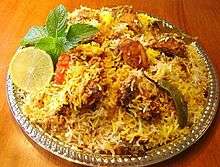
The Nawabs of Dhaka had brought Mughlai cuisine to Bengal, and with it, many Islamic elements that were wholly retained by Bangladesh's culinary community. Due to the high costs of producing Mughlai food, the recipes were limited to the elite classes in colonial India, and slowly expanded as Bangladesh's economy grew. The main focus on lamb, mutton, beef, yoghurt, and mild spices define the taste of the style. Such dishes as kebab; stuffed breads; kachi biriyani; roast lamb, duck, and chicken; patisapta; Kashmiri tea; and korma are still served at special occasions like Eid and weddings.[4][15] Due to the high class of the food, using an excess amount of expensive ingredients like ghee, and making the food melt in one's mouth were essential to the feel of the food.[16]
Specialties of Kolkata
In Kolkata, many local street vendors own small shops from which they sell their own homemade goods.[17] Items like cheeses (paneer) can be eaten as is, or can be made into sweet sandesh, rosogolla, or chanar payesh. Milk is especially used in Kolkata's various types of payesh, differing in use of different grains and additives like dates, figs, and berries.[18][19] In addition to European foodstuffs like chocolate, Kolkata takes culinary influence from its Chinese diaspora.[20] Puchka, also known as panipuri, is a common kind of Bengali street food made with a fried dough casing and a potato and chickpea filling, usually found in small stalls alongside bhelpuri, masala chai, ghugni and chaat stalls.[21]
Utensils
Another characteristic of Bengali food is the use the boti (also called the dao in some regional dialects). It is a long curved blade on a platform held down by foot; both hands are used to hold whatever is being cut and move it against the blade, which faces the user. This method gives effective control over the cutting process, and can be used to cut anything from prawn to large pumpkins.[22]
A korai is a cooking vessel for most Bengali sauces and stir-fry. The dekchi (a flat-bottomed pan) is used generally for larger amounts of cooking or for making rice. It comes with a thin flat lid which is used also to strain out the starch while finishing up cooking rice. The tawa is used to make roti and paratha.[23] The other prominent cooking utensil is a hari, which is a round-bottomed pot-like vessel. The three mentioned vessels all come in various sizes and in various metals and alloys.[24]
A flat metal spatula, khunti, is used often, along with hata (scoop with a long handle), jhanjri (round-shaped sieve-like spatula to deep-fry food), the shanrashi (pincers to remove vessels from the fire), the ghuntni (wooden hand blender) for puréeing dal, the wooden belun chaki (round pastry board and rolling pin), and the shil nora, which is a rough form of a mortar and pestle or grinding stone. The kuruni is used only to grate coconuts.[25]
Silverware is not a part of traditional Bengali cookery.[25]
Etiquette
The typical Bengali fare includes a certain sequence of food—somewhat like the courses of Western dining. Two sequences are commonly followed, one for ceremonial dinners such as a wedding and the day-to-day sequence.[26]
Historical etiquette
At home, Bengalis traditionally ate without silverware: kaţa (forks), chamoch (spoons), and chhuri (knives) gradually finding use on Bengali tables in urban areas. Most Bengalis eat with their right hand, mashing small portions of meat and vegetable dishes with rice and in some cases, lentils. In rural areas, Bengalis traditionally eat sitting on the floor with a large banana or plantain leaf serving as the plate or plates made from dried sal leaves sewn together.[27]
The procedure for hosting guests is to offer them food and drinks as soon as they enter, adapting to time. At meals, the host family may serve themselves only after guests have been served, but this must start with the respective eldest male and continue first by age and then by gender. The cook, wives, and daughter-in-laws are therefore the last to eat, as school-age children gain priority over them.[27]
Contemporary meal etiquette
Prior to colonization, adherence to meal order was a marker of social status, but with British and Portuguese influence and the growth of the middle class, this has slowly disappeared. Courses are frequently skipped or combined with everyday meals.[9] Meals were usually served course by course to the diners by the youngest housewives, but increasing influence of nuclear families and urbanisation has replaced this.[28] It is common to place everything on platters in the centre of the table, and each diner serves themselves. Ceremonial occasions such as weddings used to have elaborate serving rituals, but professional catering and buffet-style dining is now commonplace. However, large family occasions and more lavish ceremonial feasts may still abide by these rules.[28][29]
Culinary influences
Mughal influence
Muslims conquered Bengal around the mid-thirteenth century, bringing with them Persian culture and cuisine.[30] Islamic culinary influence had come from the upper classes, gradually diffusing into the local Hindu and poorer Muslim populations. Such dishes as biryani, korma and bhuna had once been meals of the higher courts, but the cooks of the Mughals brought their recipes to the lower and middle classes.[31] The influence was reinforced during the rule of the British Raj, where Kolkata became the place of refuge for many prominent exiled Nawabs, notably the family of Tipu Sultan from Mysore and Wajid Ali Shah, the ousted Nawab of Awadh. The exiles brought with them hundreds of cooks and masalchis (spice mixers), and as their royal patronage and wealth diminished, they became interspersed into the local population. These cooks came with the knowledge of a very wide range of spices (most notably jafran and mace), the extensive use of ghee, and marinating meat with yoghurt and chilli.[32]
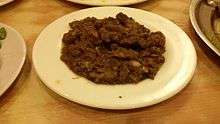
In Bangladesh, this food has become common fare for the population while in West Bengal, they have remained the food of professional chefs. Further innovations include chap (ribs slow cooked on a tawa), rezala (meat in a thin yogurt and cardamom gravy) and kathi roll (kebabs in a wrap).[32]
The Mughals had a particular fixation on meat, bringing mutton into mainstream Bengali cuisine as well as already known kinds of meat like chicken and venison.[31]
Futhermore, traditional desserts had been primarily based on rice pastes and jaggery, but under Mughal influence moved towards significantly increased use of milk, cream, and sugar along with expensive spices such as cardamom and saffron.[31]
Anglo-Indian or Raj influence
Anglo-Indian food is not purely the result of the influence of the British; Bengal was once the home of a French colony, and also hosted populations of Portuguese, Dutch, and other Europeans. These collective western influences are seen in the foods created to satisfy the tastes of the western rulers. The result is a unique cuisine, local ingredients adapted to French and Italian cooking techniques—characterised by creamy sauces, the restrained use of spices, and new techniques such as baking. English and Jewish bakers such as Flury's and Nahoum's dominated the confectionery industry which migrated from British tables to everyday Bengali ones, resulting in unique creations such as the pêţis (savory turnovers, from the English "pasty"). Another enduring contribution to Bengali cuisine is pau ruţi, or Western-style bread. Raj-era cuisine lives on especially in the variety of finger foods popularised in the 'pucca' clubs of Kolkata, such as mutton chop, kabiraji cutlet or fish orly.
The British also influenced food in a somewhat different way. Many British families in India hired local cooks, and through them discovered local foods. The foods had to be toned down or modified to suit the tastes of the "memsahibs". The most distinct influence is seen in the desserts, many of which were created specifically to satisfy the British—most notably the very popular sweet leđikeni named after the first Vicereine Lady Canning; it is a derivative of the pantua created for an event hosted by her.
Odia Influence
During the 19th century many Odia cooks migrated to Bengal to work in the households of affluent Bengali families. They were also hired to cook in marriages and other family ceremonies. Odia Brahmin cooks from Puri who worked in Jagannath Temple, known as thakurs in Bengal were in great demand. Introduction of Odia cooks into Bengali kitchens brought in subtle but significant changes to Bengali cuisine. Many of the Bengali classic dishes were originally from Odisha but were refined in Bengali kitchens by Odia cooks. In fact some researchers say that dishes like rasogola (Bengali rosogolla), kanika (Bengali misti pulao) and mangsa kawsha (Bengali kosha mangsho) were first introduced to Bengali kitchens by Odia cooks although this is contested by other researchers.[33][34] Even to this date most of the cooks in Bengali kitchens and hotels are Odia cooks.[35]
Chinese influence
The Chinese of Kolkata originally settled into a village called Achipur south of Kolkata in the late 18th century, later moving into the city and finally into its present home in Tangra at the eastern edge of Kolkata.[36] The Chinese-origin people of Kolkata form a substantial and successful community with a distinct identity.[37] With this identity came Chinese food, available at almost every street corner in Kolkata at present, due to the taste, quick cooking procedure, and no similarity with the original Chinese recipe other than the use of soy sauce. They were mostly Cantonese tradesmen and sailors who first settled down here and decided to cook with whatever items they had at hand.[38]
The influence of this unique syncretic cuisine cannot be overstated; it is available in every town in India and Bangladesh as "Chinese" food. Bengali immigrants to other countries have started carrying this abroad as well;[37] Indian Chinese restaurants have appeared in many places in the United States and UK.[39]
Indian Chinese food was given a second boost since the 1950s when a large number of Tibetans migrated into Indian Territory, following the 14th Dalai Lama's flight.[40] Tibetans brought with them their own delicacies to add to this genre, such as the very popular momo (a kind of dumpling) or thukpa (a hearty noodle soup). Tibetans and Nepali immigrants also found ready employment in kitchens and helped power the many eateries that serve this unique fusion on virtually every street in Kolkata.[41] The chop suey became a favorite, and versions like "American chop suey" and "Chinese chop suey" were constantly talked about.[42]
Meals
Daily meals are usually simple, geared to balance nutrition and makes extensive use of vegetables. The courses progress broadly from lighter to richer and heavier and goes through various tastes and taste cleansers. Rice remains common throughout the meal and is the main constituent of the meal, until the chaţni (chutney) course.[43]
First course or starter
The starting course is made from bitter vegetables or herbs, often deep fried in oil or steamed with cubed potatoes. Portions are usually tiny—a spoonful or so to be had with rice—and this course is considered to be both a palate-cleanser and of great medicinal value. The ingredients used for this course change seasonally, but commonly used ones are kôrola or uchhe (forms of bitter gourd) which are available nearly all year round, or tender neem leaves in spring.
A thick soupy mixture of vegetables in a ginger-mustard sauce called Shukto in West Bengal usually follows the bitter starting course, but sometimes replaces it as a starter altogether. Eaten in much bigger portions, Shukto is usually eaten in summer. It is a complex dish, featuring a fine balance of many different tastes and textures and is often a critical measure of a Bengali cook's abilities in the kitchen.
Shak
The first course is then followed by shak (leafy vegetables) such as spinach, palong chard, methi fenugreek, or amaranth to name a few. The shak can be steamed or cooked in oil with other vegetables such as begun (aubergine). Steamed shak is sometimes accompanied by a pungent paste of fermented mustard seeds, spices and sometimes dried mangoes, dried Indian plum and olives which is called Kashundi. Many varieties of the Shak (fried/ cooked leaves) are savored in Bengal. Methi Shak, Kormi Shak, Pui Shak, Ponka Shak, Kulekhara Shak, Sojne Shak(drum stick leaves), Hinche Shak, Neem Pata, Lau Shak, Kumro Shak, Sorshe Shak (also very common in North of India), Kochu Shak etc. are some of the varieties that are very commonly eaten in Bengali dishes. Neem Shak and Begun (Brinjal) is cooked in mustard oil (deep fried) and consumed with rice. This is a unique dish which is consumed as a normal food considering its bitter taste because of the Neem leaves.
Dal
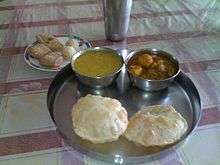
The đal course is usually the most substantial course, especially in West Bengal. It is eaten with a generous portion of rice and a number of accompaniments. Common accompaniments to đal are aaloo bhaate (potatoes mashed with rice), and bhaja (stir fried). Bhaja literally means 'fried'; most vegetables are good candidates but begun (aubergines), kumro (pumpkins), or alu (potatoes) like French fries, or shredded and fried, uchhe, potol pointed gourd are common. Machh bhaja (fried fish) is also common, especially rui (rohu) and ilish (hilsa) fishes. Bhaja is sometimes coated in a beshon (chickpea flour) and posto (poppyseed) batter. A close cousin of bhaja is bôra or deep-fried savoury balls usually made from poshto (poppyseed) paste or coconut mince. Another variant is fried pointed gourd as potoler dorma with roe/prawn.
Another accompaniment is a vegetable preparation usually made of multiple vegetables stewed slowly together without any added water. Labra, chorchori, ghonto, or chanchra are all traditional cooking styles. There also are a host of other preparations that do not come under any of these categories and are simply called tôrkari—the word merely means 'vegetable' in Bengali. Sometimes these preparations may have spare pieces of fish such as bits of the head or gills, or spare portions of meat. A charchari is a vegetable dish that is cooked without stirring, just to the point of charring.
Pickles such as raw mangoes pickled in mustard oil and spices or sweet and tangy tamarind pickles and lemon pickle are also served with the dal course. A variety of pickles are a permanent fixture of Bengali meal.
Main course
Fish
The next course is the fish course. Generally, there is one fish course a day, because Bengalis tend to eat fish and generally derive the necessary protein intake from fish and dal. Meat was generally a once-a-week affair until the 1990s, but now with changing culture, meat is served more often in the household. Generally, the most common fish dish is the Jhol, where a thin gravy of fish is made with ginger, turmeric, chili and cumin (the basic group of spices), and fish and sometimes potato or other vegetables.
Bengalis fame in cooking fish, both dried fish called "Shutki" (more present in East Bengali households) as well as fresh fish. Prawn or shrimp is often considered to be a kind of fish, and crabs are also a favourite of the Bengalis. Apart from it, mutton and chicken feature largely in the non-vegetarian menu, while the vegetarian menu contains homemade ponir, gram flour "dhoka"(deep fried fermented gram flour dough balls).
Generally, one or two pieces of fish or meat are served during lunch, with rice, to balance out the meal.
Meat
Then comes the meat course. The divide among the Bengalis of Bangladesh and West Bengal is most evident when it comes to the meat course due to the Hindu principle of ahimsa which prohibits meat consumption. Meat, especially beef is readily consumed in Bangladesh and where it is considered the meal's main course. Different beef and mutton as well as chicken are dishes are served in feasts and banquets. Because the consumption of beef is prohibited among Bengali Hindu communities, Khashi mutton is traditionally the meat of choice in West Bengal, but murgi chicken and đim eggs are also commonly consumed. At the time of Partition, it was rare for caste Hindus to eat chicken or even eggs from hens, choosing rather duck eggs if eggs were to be consumed. Although it is debatable as to whether chicken is more popular than khashi in West Bengal today, the proliferation of poultry farms and hatcheries makes chicken the cheaper alternative.
Chutney
Next comes the chutney course, which is typically tangy and sweet; the chutney is usually made of am mangoes, tomatoes, anarôsh pineapple, tetul tamarind, pepe papaya, or just a combination of fruits and dry fruits called mixed fruit chutney served in biye badi (marriage). The chutney is also the move towards the sweeter part of the meal and acts also as a palate cleanser, similar to the practice of serving sorbet in some Western cuisines.
Papoŗ (papadum), a type of wafer, thin and flaky, is often made of đal or potatoes or shagu (sago) and is a usual accompaniment to the chutneys.
Dessert
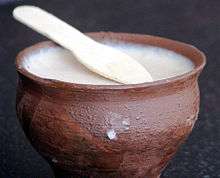
The last item before the sweets is doi (yogurt). It is generally of two varieties, either natural flavour and taste or Mishti Doi – sweet yogurt, typically sweetened with charred sugar. This brings about a brown colour and a distinct flavour. Like the fish or sweets mishti doi is typically identified with Bengali cuisine.
In a daily meal it is likely that some of the courses might get missed, for instance, the 'Shak', the additional course, chutney, and papor. In some cases, the dessert might be missed as well. The courses overall are the same at home or at a social function (e.g. marriage feast). Rice, which is the staple across the meal gets replaced by 'luchi' or luchi stuffed with dal or mashed green peas. The replacement is a relatively recent phenomenon and has been seen in practice only from about the early 20th century.
Sweetmeats
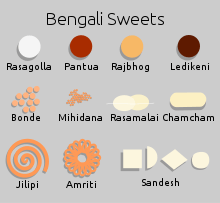
Sweetmeats, or mishti (Bengali: মিষ্টি) occupy an important place in the diet of Bengalis and at their social ceremonies. It is an ancient custom among both Hindu and Muslim Bengalis to distribute sweets during festivities. The confectionery industry has flourished because of its close association with social and religious ceremonies. Competition and changing tastes have helped to create many new sweets, and today this industry has grown within the country as well as across the world.
The sweets of Bengal are generally made of sweetened cottage cheese (chhena), unlike the use of khoa (reduced solidified milk) in Northern India. Flours of different cereals and pulses are used as well.
Shôndesh
Made from sweetened, finely ground fresh chhena (cottage cheese), shôndesh in all its variants is among the most popular Bengali sweets. The basic shôndesh has been considerably enhanced by the many famous confectioners of Bengal, and now several hundred different varieties exist, from the simple kachagolla to the complicated abar khabo, jôlbhôra or indrani. Another variant is the kôrapak or hard mixture, which blends rice flour with the paneer to form a shell-like dough that lasts much longer.
Rossogolla
Rossogolla, a Bengali traditional sweet, is one of the most widely consumed sweets in India. It spread to Bengal in 1868. Channa based sweets were introduced in Eastern India from about the 18th century; as the process and technology involved in synthesizing "Chhana" was introduced to the Indians by the Dutch in the 1790s. The cottage cheese "schmierkase" was also known as Dutch cheese.[44] The earlier versions of Rossogolla lacked binding capacity of the modern avatar that is well known and highly acclaimed today. This was due to the fact that the know-how involved in synthesizing such a sweet was unknown before being experimentally developed by Nobin Chandra Das and then constantly improved and further standardized by his successors. Furthermore, one must clearly understand that the "chhana" manufactured in those days was a coarse and granular variety and had low binding capacity. It was made by citric and ascorbic acid from natural fruit extracts. This type of "chhana" cannot be worked on to compact into any regular and firm shape for the purpose of sweet-making, leave alone making Rossogolla. This is because of a documented technological issue - lactic acid (extracted from whey) used to curdle milk now was introduced to India in the late 18th century by Dutch and Portuguese colonists (along with acetic acid)[45] - and it is this method that creates the fine, smooth modern "chhana" with high binding capacity - which is now the staple raw material for Bengali confectioners. At present, Nobin Chandra Das is referred to have invented the spongy variant of rossogolla[46]
Darbesh
Laddu (or as it is known as "darbesh" in Bengal)is a very common sweet in West Bengal and Bangladesh, as well as the rest of the subcontinent, especially during celebrations and festivities.[47][48] They are usually made out of flour, ghee/butter/oil and sugar. Alternative recipes can be made of coconut shavings and jaggery, raisins, chopped nuts, oatmeal, khoa, nutmeg, cardamom, or poppy seeds, among other ingredients.[49][50][51][52] The sweet dates back to the year 4 BCE, where it was used for medicinal purposes and to keep the hormones of 9-11-year-old girls' hormones "in check".[53]
Ras malai
Ras malai is composed of white, cream, or yellow coloured balls of channa which are dipped and soaked in sugar and malai or cottage cheese. This dessert resembles the rasgulla greatly. Though it is not a primarily Bengali sweet and originated from other places, Ras Malai is still very popular. Comilla is famous for its Rosh malai.
Pantua
Pantua is somewhat similar to the rôshogolla, except that the cottage cheese balls are fried in either ghee (clarified butter) or oil until golden or deep brown before being put in syrup. There are similar tasting, but differently shaped versions of the Pantua e.g. Langcha (cylindrical) or Ledikeni. The latter was created in honour of Countess Charlotte Canning (wife of the then Governor General to India Charles Canning) by Bhim Nag, a sweet maker in Kolkata.
Pantua is similar to gulab jamun, and could be called a Bengali variant of that dish.[54]
Chômchôm
Chômchôm, (চমচম) (originally from Porabari, Tangail District in Bangladesh) goes back about 150 years.Except that many variation of this Bangladeshi dish are now available. It can also be preserved longer. Granules of mawa or dried milk can also be sprinkled over it.
Pitha
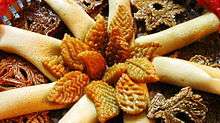
In both Bangladesh and West Bengal, the tradition of making different kinds of pan-fried, steamed or boiled sweets, lovingly known as pithe or the "pitha", still flourishes. These symbolise the coming of winter, and the arrival of a season where rich food can be included in the otherwise mild diet of the Bengalis. The richness lies in the creamy silkiness of the milk which is mixed often with molasses, or jaggery made of either date palm or sugarcane, and sometimes sugar. They are mostly divided into different categories based on the way they are created. Generally, rice flour goes into making the pithe.
They are usually fried or steamed; the most common forms of these cakes include bhapa piţha (steamed), pakan pitha (fried), and puli pitha (dumplings), among others. The other common pithas are chandrapuli, gokul, pati shapta, chitai piţha, aski pithe, muger puli and dudh puli.
The Pati Shapta variety is basically a thin-layered rice-flour crepes with a milk-custard creme-filling, similar to the hoppers or appams of South India, or French crepes. In urban areas of Bangladesh and West Bengal, most houses hold Piţha-festivals such as Nabanna.
Other sweets
Several varieties of doi such as mishţi doi, custards, and rice pudding (khir or firni)[55] are also popular in West Bengal.
Shôndesh, chhanar jilapi, kalo jam, raghobshai, "pantua", "jolbhora shondesh[56]", roshbhora", "lord chomchom", payesh, bundiya, nalengurer shôndesh, malpoa, shor bhaja, langcha, babarsa, and a variety of others are examples of sweets in Bengali cuisine.
Snacks
Muŗi
Muŗi (puffed rice) is made by heating sand in a pot, and then throwing in grains of rice. The rice may have been washed i brine to provide seasoning. The rice puffs up and is separated from the sand by a strainer. Muŗi is very popular and is used in a wide variety of secular and religious occasions, or even just consumed plain. Muri is also often used as a replacement for or in combination with regular rice.
A variant of muŗi is khoi, which is popped rice. Both varieties are used to make many different snack foods.
Jhal-Muŗi
One of the most popular and iconic snack foods of Bengal, jhal literally means 'hot' or 'spicy'. Jhal-muŗi is puffed rice with spices, vegetables and raw mustard oil. Depending on what is added, there are many kinds of jhal-muŗi but the most common is a bhôrta made of chopped shallot, jira roasted ground cumin, bitnoon black salt lôngka / morich chilis (either kacha 'ripe' or shukna 'dried'), mustard oil, dhone pata (fresh coriander leaves) and mudhi.
Moa
A moa is made by taking muri with gur (jaggery) as a binder and forming it into a ball, made all over Bengal. Another popular kind of moa is Jaynagarer Moa, a moa particularly made in Jaynagar, which uses kanakchur khoi and nolen gur as binder. Nolen gur is fresh jaggery made from the sap of date palm. Moas are made specially during winter.
Chir̦e Bhaja
Chir̦e Bhaja is made up of Flattened rice fried in sand and then strained in metal strainers, not tea strainer. It is mostly consumed with fried peanuts, jhuri-bhaja and fried curry leaves.
Tele Bhaja
Tele Bhaja is very common and popular Kolkata style fritter which is made from raw sliced vegetables or boiled and mashed vegetables mixed with spices, dipped in gram flour batter and then deep fried in oil. More western influenced cutlet type chops or fries are made by coating boiled fish or meat and pre cooked mixture of vegetables with egg yolk and breadcrumbs and then deep frying them in vegetable oil. Some very popular Tele Bhajas are Beguni, Aloor Chop, Fish kabiraji, vegetable chop etc.
Rolls
Though the culture of having several types of Rolls are not authentic Bengali cuisine but it has a partial Chinese Awadhi touch made in Bengali style. Usually common within office goers and students. Predominantly nonveg, it is prepared by lacha paratha wrapped with egg or stuffed with chicken, chicken tikka, mutton keema and so on, sometimes with paneer and onion on demand. Kolkata style Eggroll and Kathi roll are common examples of this type of snacks.
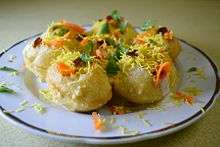
Luchi-Aloor Dum/Kochuri-AlurDam/Dalpuri-Alupuri
Luchi is a deep-fried flatbread, made of Maida (flour) while Kochuri consists of pulses stuffed in puri or luchi and paired with aloor dum or cholar dal.
Phuchka
Also known as Golgappa within North India, Kolkata's phuchka has its own flavour and taste. It is an appetizer where each small shell (Bengali: ফুচকা) is stuffed with mashed potato and tamarind water.
Chotpoti
Chotpoti is a very popular snack food item in Bengal. It is mainly cooked whole yellow peas with various spices, and dressed with smashed fuchka, boiled egg, green chilies etc. It is serve with tamarind juice (tetuler tok).
Shingara or Samosa
Shingara or Samosa is a snack created with potato and flour. This triangular shaped dish is made by making a cone using flour and pouring the cooked potato in it and after that, it is cooked in hot oil.
Gallery
 Bengali New Year Menu
Bengali New Year Menu A typical Bengali meal
A typical Bengali meal Bengali Non-vegetarian thali
Bengali Non-vegetarian thali A fancy arrangement of Bengali food
A fancy arrangement of Bengali food
References
- Nair, Rukmini. "Are we what we eat?". Retrieved 28 November 2011.
- Banerji, Chitrita (Winter 1995). "What Bengali Widows Cannot Eat". Granta (52). Archived from the original on 20 December 2011. Retrieved 28 November 2011.
- "Food Habits - Banglapedia". en.banglapedia.org. Retrieved 10 March 2019.
- "Historical Sketch | Bengal Cuisine". bengalcuisine.in. Retrieved 10 March 2019.
- "Know All About The Famous Bengali Culinary Style Popular in the Eastern Part of the Indian Subcontinent". culturalindia.net. Retrieved 18 February 2019.
- Pearce, Melissa. "Defining Bengali Cuisine: The Culinary Differences of the Bengal Region". Culture Trip. Retrieved 10 March 2019.
- Chakravarti, Sudeep. "A brief history of Adda—the Bengali fine art of discussion". Quartz India. Retrieved 17 February 2020.
- Trachtenberg, Peter (15 May 2005). "The Chattering Masses". The New York Times. ISSN 0362-4331. Retrieved 17 February 2020.
- Gaonkar, Dilip Parameshwar (2001). Alternative Modernities. Duke University Press. pp. 123–126. ISBN 978-0-8223-2714-1.
- Ahmad Mamtaz (2012). "Mezban". In Islam, Sirajul; Miah, Sajahan; Khanam, Mahfuza; Ahmed, Sabbir (eds.). Banglapedia: the National Encyclopedia of Bangladesh (Online ed.). Dhaka, Bangladesh: Banglapedia Trust, Asiatic Society of Bangladesh. ISBN 984-32-0576-6. OCLC 52727562. Retrieved 15 August 2020.
- Fayeka Zabeen Siddiqua (10 October 2013). "Majestic Mezban". The Daily Star. Archived from the original on 4 August 2018. Retrieved 23 July 2019.
- "Palate from the port". The Daily Star. 5 January 2016. Retrieved 12 July 2020.
- "Our Food Their Food: A Historical Overview of the Bengali Platter | Sahapedia". sahapedia.org. Retrieved 10 March 2019.
- "Coastal cuisines of Bangladesh". Dhaka Tribune. 24 March 2019. Retrieved 8 April 2019.
- "The Nawabs of Dhaka And Their Regal Cuisine". KIXP. 26 February 2015. Retrieved 10 March 2019.
- Anand, Shilpa Nair (7 May 2018). "Food of the Nawabs". The Hindu. ISSN 0971-751X. Retrieved 10 March 2019.
- Chitty, Tom (8 November 2018). "Kolkata: A city of arts, culture and cuisine". cnbc.com. Retrieved 9 April 2019.
- "Bengali Choshir Payesh Recipe | Choshir Paayesh". Debjanir Rannaghar. 13 January 2018. Retrieved 9 April 2019.
- "Aamer Payesh Or Mango Rice Pudding Or Aam Kheer | PeekNCook". Moumita Ghosh Recipe Blog PeekNCook. Retrieved 9 April 2019.
- "Calcutta Cuisine - Cuisine of Kolkata India - Bengali Traditional Food - What to Eat in Calcutta India". kolkata.org.uk. Retrieved 9 April 2019.
- Dugar, Divya (12 June 2015). "Kolkata food: A dining guide to restaurants and dishes". CNN Travel. Retrieved 9 April 2019.
- WildFilmsIndia (19 February 2015), Women cut vegetables at a Bengali wedding in India, using a Boti or Dao, retrieved 31 March 2019
- "www.CookingInIndia.com ~ Your Desi(Indian) Kitchen on the Net". 8 April 2008. Archived from the original on 8 April 2008. Retrieved 15 June 2019.
- "Pots, Pans and Griddles - Gourmet Online". 14 October 2008. Archived from the original on 14 October 2008. Retrieved 15 June 2019.
- "traditional indian cooking utensils - Indian Recipes, Indian Food and Cooking - FiveTastes.com". fivetastes.com. Retrieved 15 June 2019.
- "Traditional Bengali Cuisine | All The 'Slight' Details". IshitaUnblogged. 30 June 2012. Retrieved 18 February 2019.
- Shrestha, Nanda R.; Paul, Bimal K. (2002). Nepal and Bangladesh: A Global Studies Handbook. ABC-CLIO. p. 287. ISBN 978-1-57607-285-1.
- McElroy, Elroy. "Customs and Cuisine of Bangladesh | Dining for Women". Dining for Women. Retrieved 27 September 2019.
- "Bangladeshi Culture - Etiquette". Cultural Atlas. Retrieved 27 September 2019.
- Pearce, Melissa. "Defining Bengali Cuisine: The Culinary Differences of West Bengal and Bangladesh". Culture Trip. Retrieved 1 September 2019.
- "Mughalnama: changing the contours of Mughlai cuisine in India". Outlook India. Retrieved 1 September 2019.
- "All That You Ever Wanted To Know About Mughlai Cuisine!". culturalindia.net. Retrieved 1 September 2019.
- http://alexis.org.in/face-off-the-rasgulla-battle-between-west-bengal-and-odisha/
- https://www.cntraveller.in/story/odisha-indias-underrated-food-destination/
- https://timesofindia.indiatimes.com/life-style/spotlight/odia-cooks-to-bring-back-forgotten-bengali-recipes/articleshow/63761843.cms
- "Bengali cuisine,Historical influences,Characteristics of Bengali cuisine,Cooking styles,Common Bengali Recipe Styles,Culinary Influences,Bengali meals,Mishţi (sweets),Snacks". beautifulbengal.com. Retrieved 27 September 2019.
- Chapter 1. "Shodhganga" (PDF). Bit Stream.
- "Know All About The Famous Bengali Culinary Style Popular in the Eastern Part of the Indian Subcontinent". www.culturalindia.net. Retrieved 27 September 2019.
- Chapter 7. "Shodhganga" (PDF). Bit Stream.
- "Tandoori momo: how Tibetan refugees reshaped Indian cuisine". South China Morning Post. 9 July 2017. Retrieved 27 September 2019.
- "Lip-Smacking Street Food Places in Kolkata That Should Be on Every Foodies List!". www.holidify.com. Retrieved 27 September 2019.
- Deepak, Sharanya (27 April 2017). "Inside the Birthplace of Indian-Chinese Cuisine". Vice. Retrieved 27 September 2019.
- Harlan Walker (1997). Food on the Move: Proceedings of the Oxford Symposium on Food and Cookery, 1996. Oxford Symposium. pp. 288–293. ISBN 978-0-907325-79-6.
- "History of Rossogolla". Retrieved 24 August 2015.
- "The Origin of Rossogolla". Retrieved 24 August 2015.
- "History of Rasgulla". Retrieved 24 August 2015.
- "Sweet shops make hay in Diwali shine". The New Indian Express. Retrieved 18 February 2019.
- Dundoo, Sangeetha Devi (31 October 2013). "As good as home". The Hindu. ISSN 0971-751X. Retrieved 18 February 2019.
- "Dinkache ladoo, Gund ladoo, Gond Ladoo, Gond Ka Laddu.....Easy Recipes on CuisineCuisine.com". cuisinecuisine.com. Retrieved 18 February 2019.
- Collingham, Lizzie (6 February 2006). Curry: A Tale of Cooks and Conquerors. Oxford University Press. ISBN 9780198038504.
- Krondl, Michael (1 October 2011). Sweet Invention: A History of Dessert. Chicago: Chicago Review Press. p. 17. ISBN 9781569769546.
- "Oatmeal Laddu". Living Foodz. Retrieved 18 February 2019.
- "Food Story: The journey of ladoo from a medicine to the much-loved Indian sweet". The Indian Express. 16 October 2014. Retrieved 18 February 2019.
- Charmaine O'Brien (3 February 2003). Flavours of Delhi: A Food Lover's Guide. Penguin Books Limited. p. 145. ISBN 978-93-5118-237-5.
- "Notun Gurer Payesh/Traditional Bengali Rice Pudding | Remembering My Dida". IshitaUnblogged. 30 May 2012. Retrieved 18 February 2019.
- Walker, Harlan (2000). Milk-- Beyond the Dairy: Proceedings of the Oxford Symposium on Food and Cookery 1999. Oxford Symposium. p. 308. ISBN 978-1-903018-06-4.
Further reading
- Ray, Krishnendu (2004). The migrant's table: meals and memories in Bengali-American households. Temple University Press. ISBN 1-59213-096-8. Retrieved 14 October 2011.